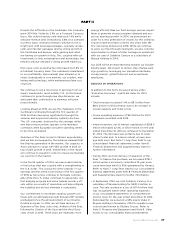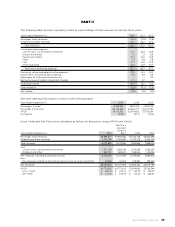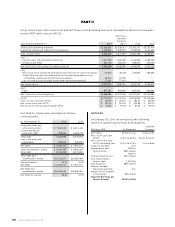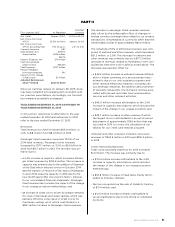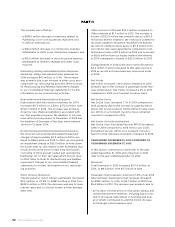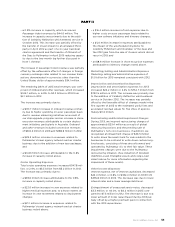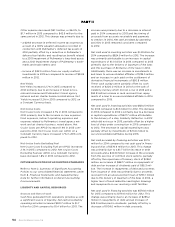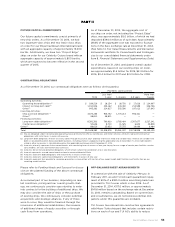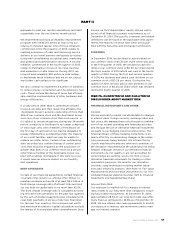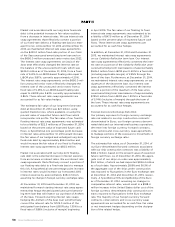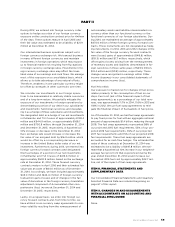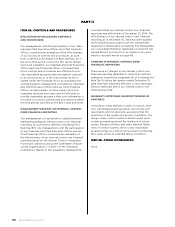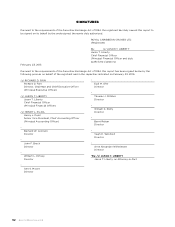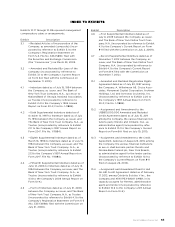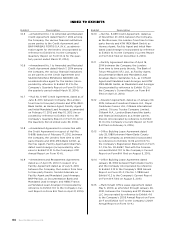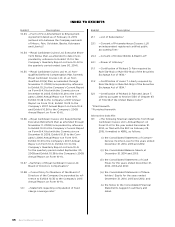Royal Caribbean Cruise Lines 2014 Annual Report Download - page 58
Download and view the complete annual report
Please find page 58 of the 2014 Royal Caribbean Cruise Lines annual report below. You can navigate through the pages in the report by either clicking on the pages listed below, or by using the keyword search tool below to find specific information within the annual report.
Royal Caribbean Cruises Ltd. 57
PART II
adequate to meet our capital expenditures and debt
repayments over the next twelve-month period.
We implemented a broad profitability improvement
program with initiatives aimed at improving our
returns on invested capital. One of those initiatives,
commenced in the third quarter of 2013, relates to
realizing economies of scale and improving service
delivery to our travel partners and guests by restruc-
turing and consolidating our global sales, marketing
and general and administrative structure. A second
initiative, commenced in the fourth quarter of 2013,
relates to Pullmantur’s focus on its cruise business
and expansion in Latin America. During 2014, we
incurred approximately $30 million in cash outlays
to implement these initiatives and we do not expect
any further cash outlays to be significant.
We also continue to implement a number of initiatives
to reduce energy consumption and, by extension, fuel
costs. These include the design of more fuel efficient
ships and the implementation of other hardware and
energy efficiencies.
If (i) any person other than A. Wilhelmsen AS and
Cruise Associates and their respective affiliates (the
“Applicable Group”) acquires ownership of more than
33% of our common stock and the Applicable Group
owns less of our common stock than such person, or
(ii) subject to certain exceptions, during any 24-month
period, a majority of the Board is no longer comprised
of individuals who were members of the Board on
the first day of such period, we may be obligated to
prepay indebtedness outstanding under the majority
of our credit facilities, which we may be unable to
replace on similar terms. Certain of our outstanding
debt securities also contain change of control provi-
sions that would be triggered by the acquisition of
greater than 50% of our common stock by a person
other than a member of the Applicable Group cou-
pled with a ratings downgrade. If this were to occur,
it would have an adverse impact on our liquidity
and operations.
DEBT COVENANTS
Certain of our financing agreements contain financial
covenants that require us, among other things, to
maintain minimum net worth of at least $6.2 billion, a
fixed charge coverage ratio of at least 1.25x and limit
our net debt-to-capital ratio to no more than 62.5%.
The fixed charge coverage ratio is calculated by divid-
ing net cash from operations for the past four quarters
by the sum of dividend payments plus scheduled prin-
cipal debt payments in excess of any new financings
for the past four quarters. Our minimum net worth
and maximum net debt-to-capital calculations exclude
the impact of Accumulated other comprehensive (loss)
income on Total shareholders’ equity. We are well in
excess of all financial covenant requirements as of
December 31, 2014. The specific covenants and related
definitions can be found in the applicable debt agree-
ments, the majority of which have been previously
filed with the Securities and Exchange Commission.
DIVIDENDS
In December 2014, we declared a cash dividend on
our common stock of $0.30 per share which was paid
in the first quarter of 2015. We declared a cash divi-
dend on our common stock of $0.30 per share during
the third quarter of 2014 which was paid in the fourth
quarter of 2014. During the first and second quarters
of 2014, we declared and paid a cash dividend on our
common stock of $0.25 per share. During the first
quarter of 2014, we also paid a cash dividend on our
common stock of $0.25 per share which was declared
during the fourth quarter of 2013.
ITEM 7A. QUANTITATIVE AND QUALITATIVE
DISCLOSURES ABOUT MARKET RISK
FINANCIAL INSTRUMENTS AND OTHER
General
We are exposed to market risk attributable to changes
in interest rates, foreign currency exchange rates and
fuel prices. We manage these risks through a combina-
tion of our normal operating and financing activities
and through the use of derivative financial instruments
pursuant to our hedging practices and policies. The
financial impact of these hedging instruments is pri-
marily offset by corresponding changes in the under-
lying exposures being hedged. We achieve this by
closely matching the amount, term and conditions of
the derivative instrument with the underlying risk being
hedged. Although certain of our derivative financial
instruments do not qualify or are not accounted for
under hedge accounting, we do not hold or issue
derivative financial instruments for trading or other
speculative purposes. We monitor our derivative
positions using techniques including market valua-
tions and sensitivity analyses. (See Note 14. Fair Value
Measurements and Derivative Instruments to our con-
solidated financial statements under Item 8. Financial
Statements and Supplementary Data.)
Interest Rate Risk
Our exposure to market risk for changes in interest
rates relates to our long-term debt obligations includ-
ing future interest payments. At December 31, 2014,
approximately 28.5% of our long-term debt was effec-
tively fixed as compared to 34.6% as of December 31,
2013. We use interest rate swap agreements to modify
our exposure to interest rate movements and to man-
age our interest expense.


